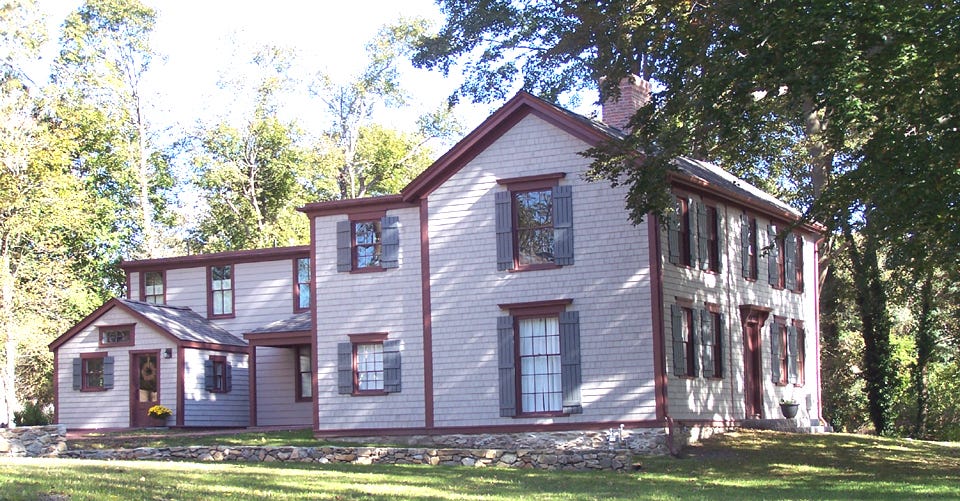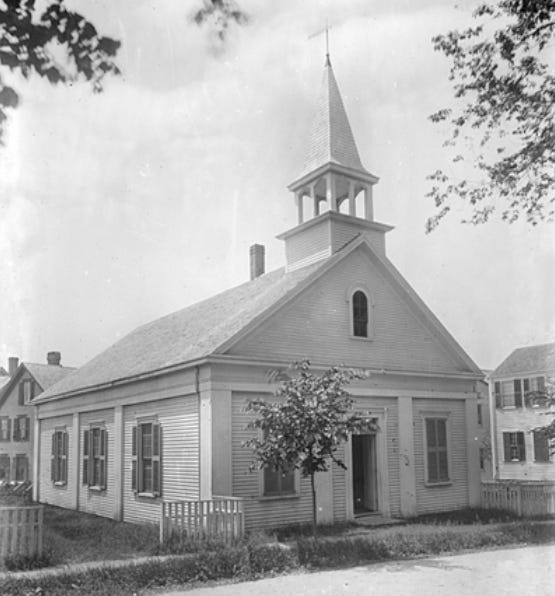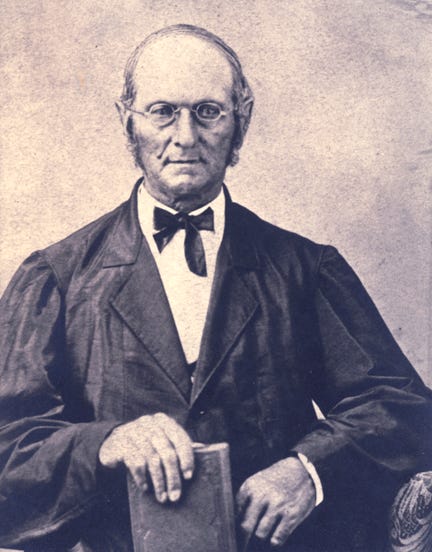The end of the world was coming. Soon. So believed a number of people in Fairhaven and throughout New England during the 1830s and 1840s. Traveling preachers spread the word that Biblical signs of Christ’s Second Coming were appearing—meteor showers, a bright comet, and other signals in the heavens—heralding the Savior’s return. More importantly, precise mathematical calculations by William Miller, a Baptist farmer from upstate New York, added more scientific weight to the predictions. As Miller lectured and distributed tracts across New England he gained thousands of followers who became convinced that Christ would reappear on earth between March 21, 1843, and March 21, 1844.
One of Miller’s most outspoken followers was a young retired sea captain from Fairhaven named Joseph Bates. Based on Miller’s teachings and further study he undertook himself, Bates’ own religious preaching and writing led to the founding of the Seventh-day Adventist Church, which nearly a century and a half later has millions of followers in more than 200 countries around the world.
Joseph Bates Jr. was born to Joseph and Deborah Bates in Rochester in 1792, the fourth of seven children. The following year, his father, a merchant and Revolutionary War veteran, moved the growing family to a house in Oxford Village, then still a part of New Bedford. The home was among the first in that section of Fairhaven, having been built by William Wood in 1742, before the establishment of the village in that area. Like many young men growing up by the Acushnet River, Joseph Bates Jr. longed to go to sea. He finally did so at the age of 15, as a cabin boy on the ship Fanny.

Unfortunately, on one of his earliest voyages, Bates and several other crewmen were impressed into service by the British navy and then held at Dartmoor Prison in England throughout the War of 1812. In April 1815, the prisoners were finally released and Joseph Bates returned to Fairhaven in June, following an absence of several years. After a stay at home of only a few weeks, Bates was off to sea again, this time as a second mate on a merchant voyage to Europe. By the age of 28, Bates was a full-fledged captain.
In the meantime, he was married to Miss Prudence Nye, whom he had known since childhood. Although his parents were members of the First Congregational Church, Joseph Sr. being a Deacon of the church, Joseph Jr. joined the Christian Church that his wife had become involved with. This group subscribed to no particular creed, but took the Biblical scriptures as their sole guide. While having Baptist leanings, they were liberal in practice, promoting individual freedom of thought.
Besides his devotion to the Christian Church, Bates also adhered to principles of sobriety, giving up hard liquor, then wine and beer and finally even coffee and tea. In 1824, he wrote and signed his own personal covenant to serve God. In 1827, he helped found the Fairhaven Temperance Society, the first organization of its kind in America. The same year, he announced to the crew of his ship, Empress, that, except for the presence of two bottles in the medicine chest, they were sailing with no liquor onboard. (This announcement was made after they were already at sea.) It is said that it was the first instance of a “dry” ship sailing from the port of New Bedford.
In 1828, Bates retired from the sea at the age of 35 with a small fortune of about $11,000. He devoted his time to his Fairhaven farm and to his various moral causes. In 1832, he, along with Warren Delano I and Jabez Delano, oversaw the building of the Washington Street Christian Meeting-house. Bates also was an active member of the Fairhaven Antislavery Society.
Then in 1833, the stars started falling from the heavens.
In mid-November of 1833, a spectacular meteor shower was viewed by many as one of several “portentous signs in the heavens” that moral reform was needed. At the same time, Millerites or Adventists were predicting the Apocalypse was fast approaching. In 1839, a minister friend invited Joseph Bates to a lecture in New Bedford on the subject of the Second Coming of Christ. Here Bates learned of William Miller’s predictions and after studying Miller’s writing, he became an avid supporter and promoter of the Adventist message.
In 1840, Joseph Bates, along with William Milller, Boston Adventist publisher Joshua V. Himes and thirteen others, published a call for a General Conference on the coming of the Lord to be held in Boston. The success of the two-day conference brought about increased awareness of the predicted Second Advent.
Bates invited William Miller to Fairhaven. On March 15, 1841, Miller began delivering a series of fifteen lectures at the Washington Street Christian Meeting-house. According to Bates, “The house was so crowded that a great portion could not be seated, and yet all was quiet and still as night.” The lectures were the talk of the town. Thirty-three members of the Christian Church broke off and, joining with others, formed the Second Advent Society of Fairhaven.

The following week Miller spoke at the North Christian Meeting-house in New Bedford, again causing a sensation, even among the clergy.
Bates devoted almost his entire attention to the Adventist movement, which caused some friction at the Washington Street church, where not everyone shared his view. After a great deal of soul-searching, Bates withdrew from the church that had been built through a great deal of his own effort.
Shortly after the withdrawal of Bates and other Adventists, the members of the Washington Street Christian Meeting-house hired a Unitarian minister.
There was, as one might guess, a major hurdle set in the path of the Adventists when three specific dates predicted for the Second Coming in 1843 and 1844 came and went without the Lord’s arrival. Bates himself said, “You can have no idea of the feeling that seized me. I had been a respected citizen, and had with much confidence exhorted the people to be ready for the expected change. . . . If the earth could have but opened and swallowed me up, it would have been sweetness compared to the distress I felt.” This time became known as the Great Disappointment and many Adventists—some of whom had rid themselves of all their earthly goods in anticipation of the world’s end—left the fold. Others, including Miller and Bates, concluded there must have been something wrong with the calculations, but try as they might they couldn’t find an error. They determined, however, that the Advent was near and that mankind should be prepared for it.
In 1845, Joseph Bates came across a tract published by Thomas Preble outlining the idea that the Sabbath should be kept on Saturday—the seventh day of the week—rather than on Sunday. Bates traveled to New Hampshire and met with several “Sabbathkeepers.” He was soon convinced that their claims were true. He also decided that the Second Advent had not occurred as expected because most Christians were worshiping on the wrong day of the week, in effect violating the fourth commandment. Returning to Fairhaven, legend has it Bates was greeted by a friend, Capt. Hall, who said, “What’s the news, Captain Bates?” To which Bates responded, “The news is that the seventh day is the Sabbath!”
Bates developed his theory and wrote a 48-page pamphlet, “The Seventh-day Sabbath, A Perpetual Sign,” and had it printed by Benjamin Lindsey of New Bedford in August of 1846. Bates sent a copy of his tract to James White, an Adventist minister, who, with his wife Ellen, was continuing to spread the Adventist word. Ellen White claimed to have visions from God, which some were skeptical of but which also drew a large number of followers. When Ellen White told of a new vision which confirmed Joseph Bates’ theory, the Seventh-day Adventist message grew in popularity.
By this time, Joseph Bates had virtually no money left of the fortune he had retired with. As he sat down to write a second tract, his wife Prudence told her husband that she needed flour to finish her baking. With his last twelve-and-a-half cents, Bates bought just enough flour for his wife’s immediate needs. When Mrs. Bates asked why he had bought so little, Bates told her he had spent the last money he had. “But what shall we do?” Prudence asked.
“I’m going to write a book . . . and spread this Sabbath truth before the world,” he replied.
“But what are we going to live on?”
“The Lord is going to open the way,” said Bates.
Later that day, Bates went to the post office and found he had received a letter with a ten dollar donation to help him with his work. With it, he restocked the pantry cupboards and made arrangements to print his next booklet. It seemed as though the Lord had, indeed, opened the way.
Joseph Bates spent the rest of his life spreading the word, traveling, preaching, chairing conferences. In 1858 he finally sold his Fairhaven property, paid off all his personal debts and moved to Michigan, where the Seventh-Day Adventists were settling in and around Battle Creek. In 1858, Bates began writing a series of autobiographical articles on his life. These were published in The Youth’s Instructor, a monthly periodical produced by the Seventh-day Adventist Publishing Association, which also published The Advent Review and Sabbath Herald weekly.
On May 21, 1863, at Battle Creek, the Seventh-day Adventist Church was officially organized. By 1885 there were more than 20,000 members.
In 1868 Bates’ writings on his earlier life were collected in the book The Autobiography of Elder Joseph Bates. The book has rarely been out of print since.
Joseph Bates Jr. died at Battle Creek, Michigan, in 1872. He had written in his autobiography, “It is my earnest desire to spend the remainder of my days in the service of God, and for the advancement of his truth, that I may have a place in his soon-coming kingdom.”
Joseph Bates’ boyhood home in Fairhaven, now numbered 191 Main Street, passed from the Bates family to Mrs. Ann Hathaway who bought it for $450 and gave it to her daughter, Mrs. Paul Burgess, in 1835. Amazingly, it remained in the same family for 170 years, passing through six generations from Burgesses to Marstons to Mrs. Genevieve (Marston) Darden and her husband Hugh B. Darden. Over the years, groups of Seventh-day Adventists from all over the United States have come to Fairhaven to visit the home.
In 1960, Mrs. Darden wrote an article on the Seventh-day Adventists’ annual pilgrimages to her home, which was published in Yankee magazine. She wrote, “The sunny corner room which is simply the ‘west bedroom’ to us is, to the Adventists, a modest shrine [because] Joseph Bates slept there, and was, presumably, spiritually nurtured and inspired there. . . .” About the hundreds of religious pilgrims she and her husband welcomed onto their property, she concluded, “I have come to like and admire our visitors a great deal.”
Mrs. Darden died in 2003 at the age of 88, and in 2005 the house was put up for sale. It was purchased by the Adventist Heritage Ministry. The group owns and maintains a number of historical properties associated with the history of the Seventh-day Adventist Church. Extensive restoration work on the house, informative interior displays, and the construction of a “carriage house” and parking area have since been completed. Today the Joseph Bates Jr. Boyhood Home hosts visitors from around the world.
COPYRIGHT © 2006, 2025 by Christopher J. Richard. All rights reserved. Updated from an article first published in Fairhaven’s Monthly Navigator.






Thanks for sharing another interesting piece of Fairhaven’s history.
Love your Substack! Thanks for sharing these stories